Creating a Pebble Mosaic Pathway: A Step-by-Step Guide
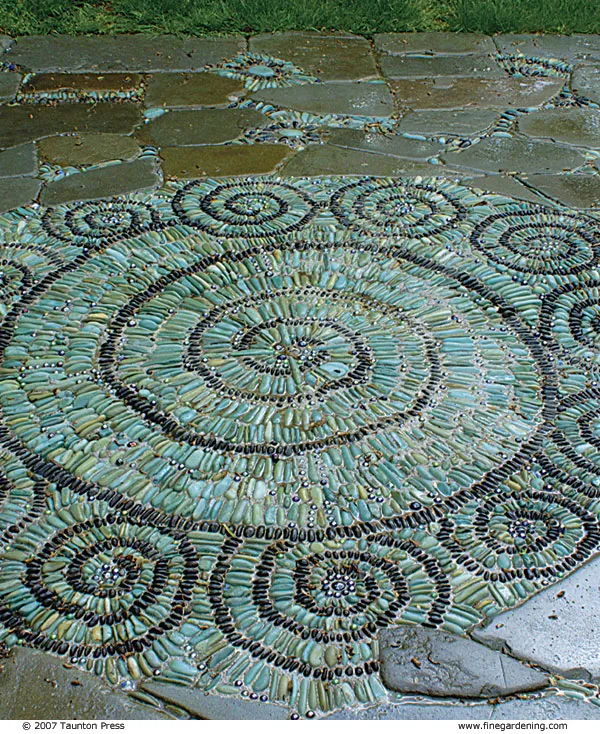
Hey there, fellow art enthusiasts! Robert Kline here, and I’m thrilled to share my long-time passion for pebble mosaics with you. There’s something truly captivating about transforming simple stones into intricate works of art. Today, I’ll be guiding you through the process of crafting your own stunning mosaic garden stepping stone path, a project that’s both fulfilling and accessible for any skill level.
Inspiration from Abroad
My fascination with pebble mosaics began years ago during my travels through Spain and Portugal. The sheer beauty of the intricately designed pavements, like those in Seville’s Plaza de España and the streets of Lisbon, ignited a spark in me. Witnessing the transformation of ordinary river pebbles into breathtaking patterns made me realize the artistic potential that lay dormant within these humble materials.
The Allure of Pebble Mosaics
What I find most appealing about this art form is its versatility and affordability. With a bit of creativity and some readily available materials, you can create stunning pathways, patios, walls, and even decorative elements for your garden. The possibilities are endless!
 The outer spirals of this design represent the full moons of the year. It’s made with green and black pebbles and iridescent glass marbles.
The outer spirals of this design represent the full moons of the year. It’s made with green and black pebbles and iridescent glass marbles.
A pebble mosaic stepping stone featuring a spiral design made with green, black, and iridescent glass elements.
Gathering and Sorting Your Pebbles
The key to a smooth mosaic creation process lies in meticulous preparation. Before you even think about mortar, take the time to sort your pebbles by color and size. This step is crucial, especially if you plan on creating specific patterns. Trust me, your future self will thank you!
Pro Tip: Wetting the stones reveals their true colors and patterns, making the sorting process much easier. Large plastic tubs come in handy for this task.
Sourcing Your Stones
While pre-sorted pebbles are available for purchase, I find immense satisfaction in collecting my own. Riverbeds, gravel bars, and even your own backyard can be treasure troves of unique and beautiful stones. Remember to check local regulations before collecting, and always be mindful of the environmental impact.
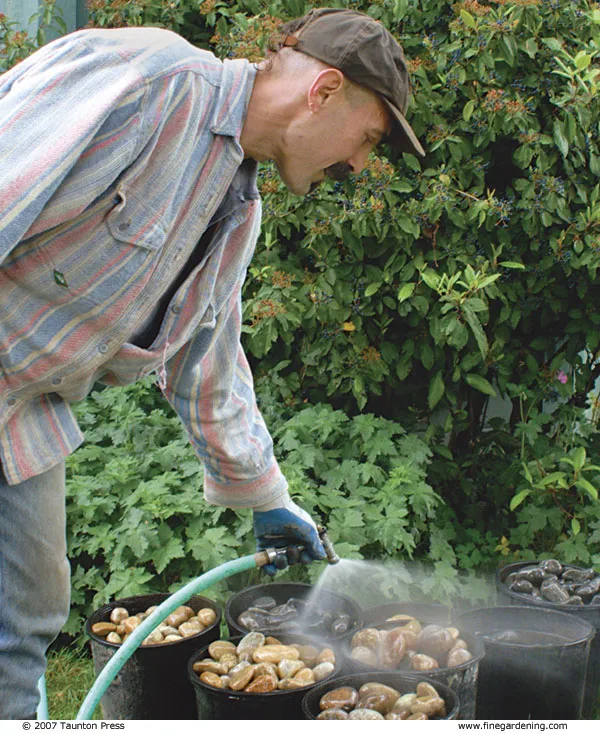 Author wetting rocks in buckets to accentuate their color distinctions.
Author wetting rocks in buckets to accentuate their color distinctions.
Sorting and wetting pebbles helps to reveal their unique colors and patterns.
Tools and Materials
Here’s what you’ll need for your pebble mosaic pathway:
Tools:
- Contractor’s wheelbarrow
- Garden hoe
- Garden hose and spray nozzle
- Garden or concrete trowel
- Short stool
- Sturdy rubber gloves
- Dust mask
- Contractor’s-grade 1/2-inch thick plywood (3-foot by 3-foot sheet)
- Rags
- Respirator (optional)
Materials:
- Material for forms (2×6 lumber and stakes, sturdy plastic edging, or bender board)
- Crushed gravel for the base
- Premixed dry mortar (one 80-pound bag provides a base for 3 to 4 square feet of mosaic)
- Sorted pebbles
- Muriatic acid (optional, for cleaning)
Designing and Prepping Your Pathway
Before you start laying down stones, it’s crucial to have a plan. Sketch out your desired pattern on paper, and then do a rough layout on your chosen site. This step helps visualize the final result and ensures that everything fits together seamlessly.
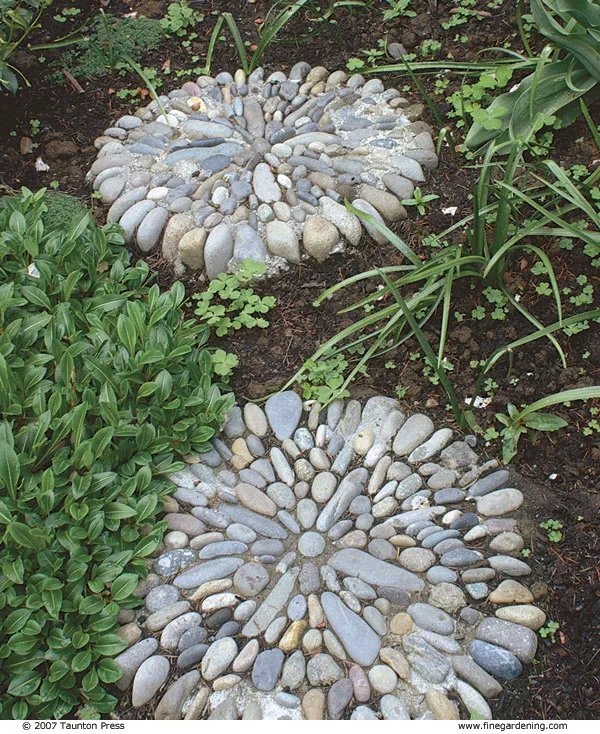 These stepping stones were built without forms.
These stepping stones were built without forms.
Simple pebble mosaic stepping stones can be created without the use of forms.
Creating a Solid Foundation
Once you’re happy with your design, excavate the pathway area to a depth of about 5 inches. Ensure a level and smooth surface, incorporating a slight grade for drainage if needed. Add a 2-inch layer of compacted crushed gravel as a base, followed by a 3-inch bed of mortar.
Important Note: In regions with frost heave, consult with your local building department for recommendations on a frost-resistant base.
Forms for a Defined Look
For straight pathway edges, construct forms using stakes and 2×6 boards before adding the gravel base. For curved pathways, flexible materials like sturdy plastic edging or bender board work well. Remember, the top of the form will guide your mosaic’s level, so accuracy is key.
Mixing and Applying the Mortar
Mortar, not concrete, is the secret ingredient for durable pebble mosaics. When you’re ready to start laying your stones, mix small batches of mortar to a thick pudding consistency. Working quickly is crucial, as mortar begins to set within 20 minutes.
Embedding Your Stones
Spread a layer of mortar over a small section of your prepared base, aiming for a depth of about half an inch below the desired finished level. Start embedding your pebbles, ensuring they are firmly pressed into the mortar with more than half of their depth submerged.
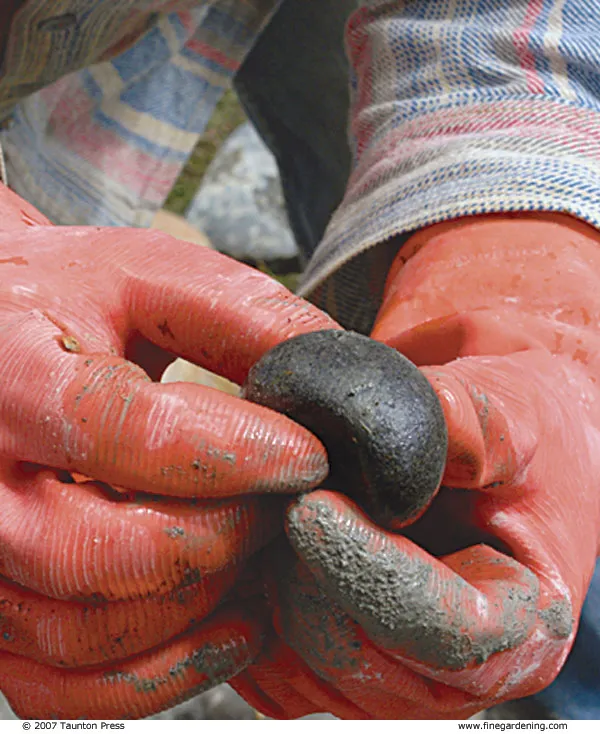 close-up of gloved hands holding a smooth rock.
close-up of gloved hands holding a smooth rock.
Choose smooth rocks with a relatively flat side for optimal embedding in the mortar.
Leveling and Setting
Once you’ve filled a section with pebbles, place a sheet of plywood over the area and step on it to level the stones with the form’s top edge. Repeat as needed, then gently spray away excess mortar, revealing your mosaic’s intricate pattern.
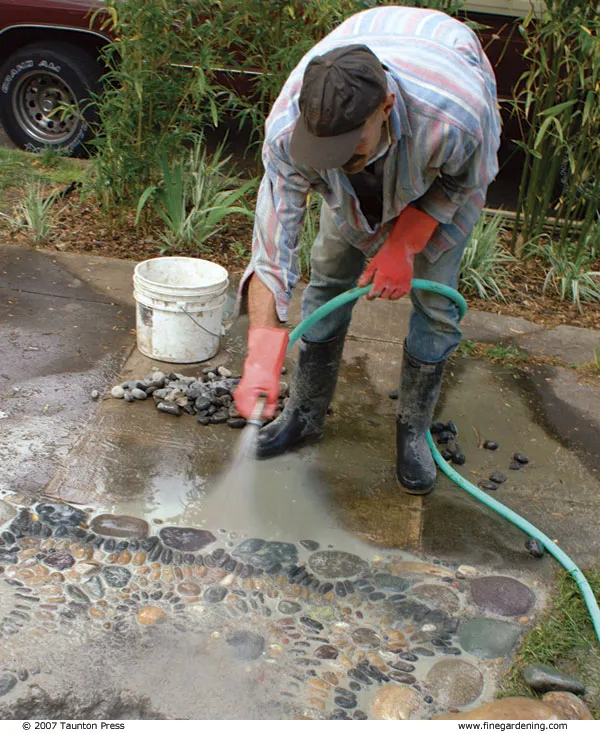 Author spraying mosaic with hose to clean off any displaced mortar.
Author spraying mosaic with hose to clean off any displaced mortar.
Gently spraying the mosaic with a hose helps to remove displaced mortar and reveal the design.
Finishing Touches and Maintenance
Allow the mortar to cure completely, misting it with water for a few days to prevent cracking. Once dry, consider cleaning the mosaic with a diluted muriatic acid solution to remove any residual mortar film. Always wear protective gear when handling this acid.
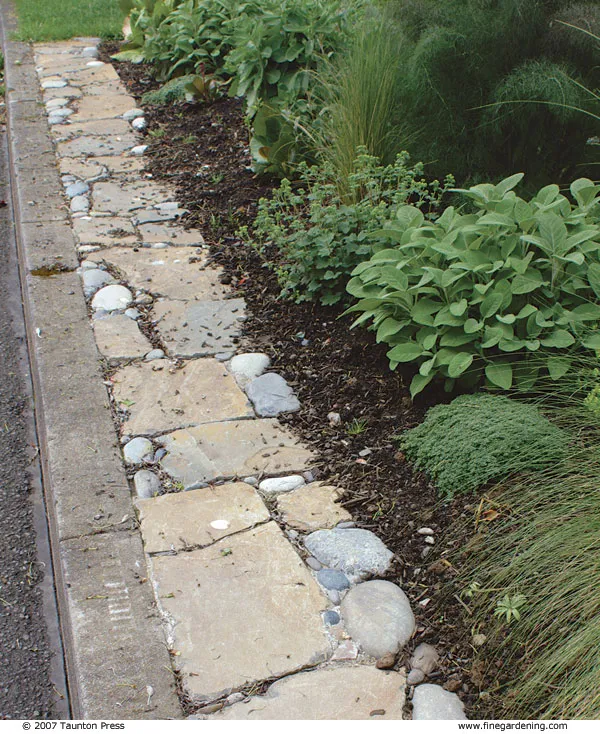 Pebbles fill the spaces between large flat stones in this edging along a streetside curb.
Pebbles fill the spaces between large flat stones in this edging along a streetside curb.
Pebble mosaics can also be used to create beautiful and functional edging for gardens and pathways.
The Magic of Pebble Mosaics
Creating a pebble mosaic pathway is a labor of love, but the end result is truly rewarding. The intricate patterns, the play of light and shadow on the stones, and the satisfaction of having crafted something beautiful with your own hands—it’s an experience like no other.
So, gather your materials, unleash your inner artist, and embark on the fulfilling journey of creating your own pebble mosaic masterpiece. And remember, the team at Robert Kline Art is always here to offer support and inspiration.
What unique designs and patterns can you envision for your own pebble mosaic pathway? Share your thoughts and ideas in the comments below. Let’s inspire each other!
For even more unique, handcrafted gift ideas, be sure to explore the rest of the Robert Kline Art website. You’re bound to find something special for everyone on your list.
